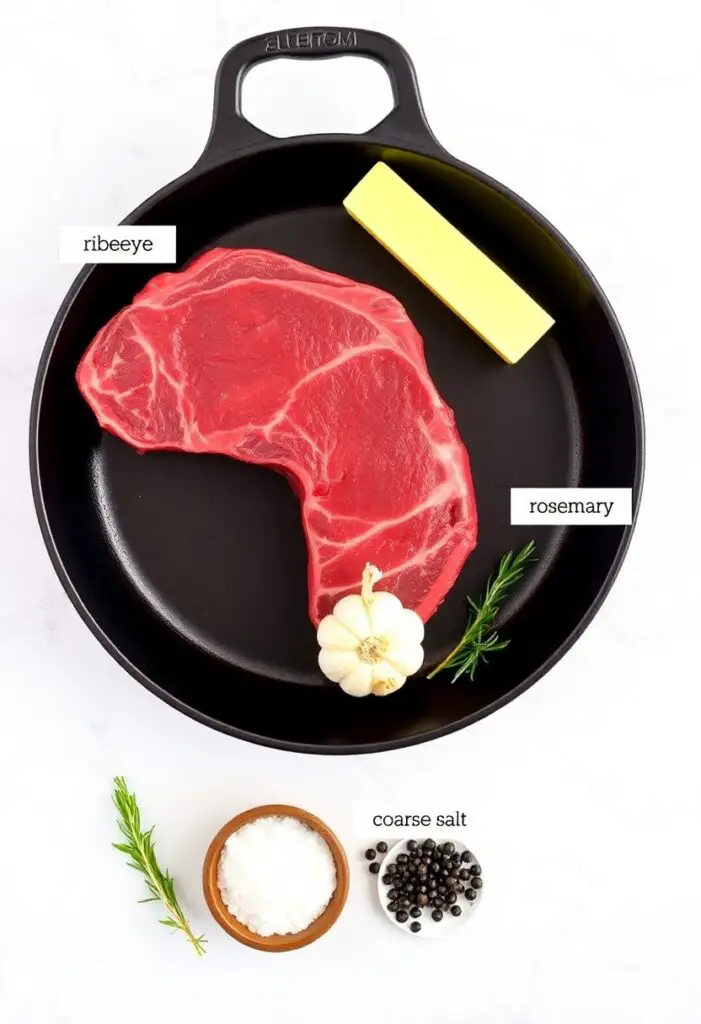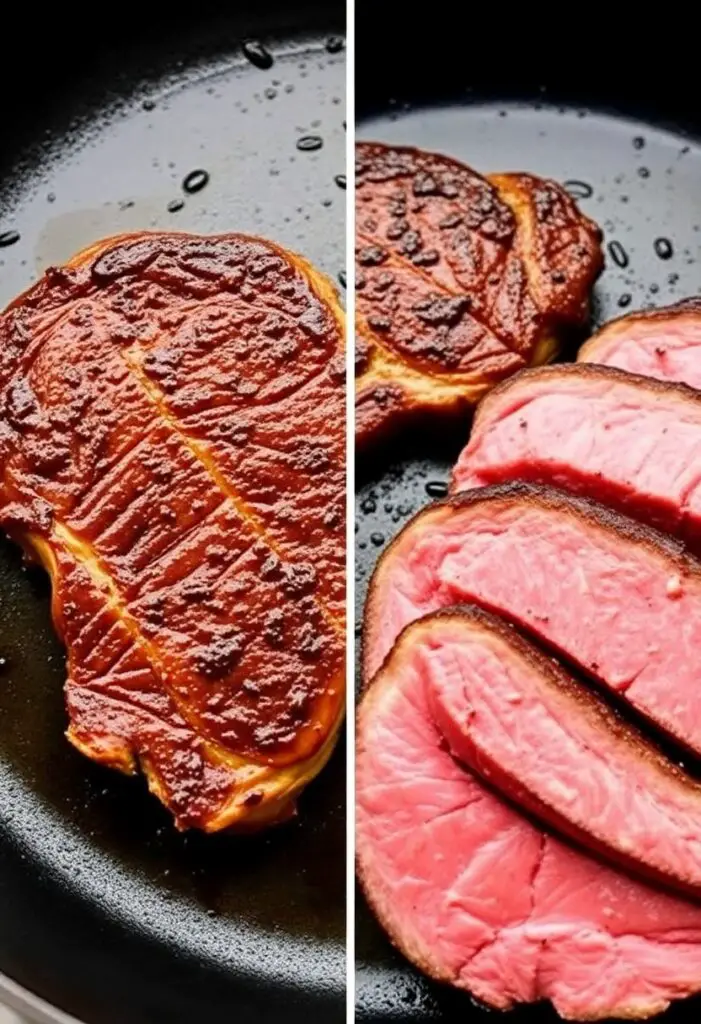How to Cook Steak in Cast Iron Skillet (The Only Way You’ll Ever Need!)
Okay, let’s talk steak. We’ve all been there, right? You spend good money on a beautiful cut of beef, bring it home with high hopes, and then… you manage to turn it into something resembling shoe leather. Or, worse, it’s gray on the outside and barely warm on the inside. Tragic! But what if I told you that achieving that perfect, restaurant-quality steak with a gorgeous, deeply browned crust and a tender, juicy interior is not only possible but actually easy? My friend, if you own a cast iron skillet, you hold the power to unlock steak nirvana. Today, you are going to master how to cook steak in cast iron skillet – a technique so simple and effective, you’ll wonder why you ever did it any other way.
Why This Recipe Is Awesome (Your Ticket to Steakhouse Glory)
Why is the cast iron skillet the undisputed champion for cooking steak? Because it delivers results that other pans just can’t match. This method is awesome because:
- The Crust, Oh That Crust! A screaming hot cast iron skillet creates an unparalleled, deeply caramelized crust, full of savory flavor. It’s the Maillard reaction, baby, and it’s spectacular.
- Juicy, Tender Interior: The high, even heat of cast iron sears the exterior quickly, locking in all those precious juices for a perfectly pink, tender inside. No more sad, gray bands of despair!
- Surprisingly Fast: From searing to basting to resting, you’re looking at under 15 minutes of active cooking. It’s quicker than calling for takeout in Khulna, that’s for sure.
- Minimalist Magic: You don’t need fancy equipment, just a trusty cast iron pan and a few basic ingredients.
- Impress Anyone (Including Yourself): Seriously, once you master this, you’ll be making steaks that rival your favorite upscale restaurant, and everyone will think you’re a culinary genius. You are a culinary genius!
This isn’t just a recipe; it’s a fundamental cooking skill that will elevate your entire culinary game. Get ready to transform your steak experience forever.
Ingredients: Your Lean, Mean Steak Machine
Quality ingredients are key here. Don’t skimp, but don’t overcomplicate it either.
- 1 (1.5-inch thick) boneless steak, such as Ribeye, New York Strip, or Filet Mignon (about 12-16 ounces)
- 1 tablespoon high-smoke-point oil (like avocado, grapeseed, or canola oil)
- 1 tablespoon unsalted butter
- 2 cloves garlic, lightly smashed (don’t peel!)
- 1 sprig fresh rosemary or thyme (optional, but adds amazing aroma)
- Coarse salt, like Kosher salt or sea salt (be generous!)
- Freshly cracked black pepper
A Very Important Note on Your Steak:
- Thickness is Your Friend: Aim for a steak that’s at least 1.25 to 1.5 inches thick. Thicker steaks give you more time to develop that crust without overcooking the inside.
- Room Temp Rules: Pull your steak out of the fridge at least 30-60 minutes before cooking. A room-temperature steak cooks more evenly.
Tools & Kitchen Gadgets Used: Your Cast Iron Crew
This is all about leveraging the power of that glorious skillet.
- A 10-inch or 12-inch Cast Iron Skillet (The star of the show!)
- Tongs (Never, ever pierce your steak with a fork!)
- Instant-Read Meat Thermometer (Your non-negotiable secret weapon for perfect doneness!)
- A Large Spoon (for basting)
- Paper Towels
- Cutting Board
Step-by-Step Instructions: The Path to Cast Iron Perfection
This whole process moves pretty fast, so have all your ingredients prepped and laid out by your stove before you even think about turning on the heat.
Act 1: The Prep (Dryness is Godliness)
- Bring to Room Temp: Take your steak out of the fridge 30-60 minutes before you plan to cook. Let it chill out (pun intended) on the counter.
- Pat It DRY (CRITICAL STEP!): Use paper towels to generously pat the entire steak completely dry. I’m talking seriously dry. Any moisture on the surface will create steam, which prevents that amazing crust from forming.
- Season Liberally: Just before cooking, season both sides of the steak with a generous amount of coarse salt and freshly cracked black pepper. Don’t be shy with the salt; it’s key for the crust and flavor.
Act 2: The Searing & Basting (The Sizzle is Real!)
- Heat the Skillet (SMOKING HOT!): Place your cast iron skillet over high heat. Let it heat up for a good 3-5 minutes until it’s smoking lightly. This is essential. If it’s not smoking, it’s not hot enough for that epic crust.
- Add the Oil: Drizzle the high-smoke-point oil into the hot skillet. It should shimmer immediately and might smoke a tiny bit more.
- Sear the First Side (2-3 Minutes): Carefully place the seasoned steak into the smoking hot, oiled skillet. Press it down gently with your tongs to ensure maximum contact. Let it cook, undisturbed, for 2 to 3 minutes until it forms a deep, dark, crusty sear. Resist the urge to move it!
- Flip and Sear Second Side (2-3 Minutes): Using your tongs, flip the steak. Sear the second side for another 2 to 3 minutes to develop a similar crust.
- Add the Aromatics & Butter: Reduce the heat to medium. Add the butter, smashed garlic cloves, and herb sprigs (if using) to the pan.
- The Butter Baste (1-2 Minutes): As the butter melts and foams, tilt the skillet slightly towards you. Use a large spoon to continuously baste the melting butter, garlic, and herbs over the top of the steak. Do this for 1 to 2 minutes, flipping the steak once or twice during basting to coat both sides with that incredible flavor.
Act 3: The Rest (Don’t You Dare Skip This!)
- Check for Doneness: This is where your instant-read meat thermometer becomes your best friend. Insert it into the thickest part of the steak, avoiding any bone.
- Rare: 120-125°F (49-52°C)
- Medium-Rare: 125-130°F (52-54°C) – IMO, the sweet spot for most steaks!
- Medium: 130-135°F (54-57°C)
- Medium-Well: 135-140°F (57-60°C)
- Well-Done: 140-145°F (60-63°C) (If you insist, but seriously, don’t.)
- Crucial Tip: Remove the steak from the pan when it’s about 5°F (3°C) below your desired final temperature. It will continue to cook as it rests.
- REST THE STEAK (ABSOLUTELY ESSENTIAL!): Transfer the steak to a clean cutting board. Tent it loosely with foil. Let it rest for at least 5-10 minutes. This allows the juices to redistribute throughout the meat, resulting in a tender, juicy steak. If you cut it too soon, all those delicious juices will run out onto your board, and you’ll be left with a dry, sad steak. You wouldn’t want that, would you?
- Slice and Serve: After resting, slice the steak thinly against the grain. Drizzle with any leftover butter from the pan. Serve immediately and enjoy the masterpiece you’ve created!
Calories & Nutritional Info (Per 4-ounce Cooked Serving)
Steak in a cast iron skillet is pure, delicious protein!
- Estimated Calories per serving: ~350-500 calories (depending on cut and fat content)
- Protein: ~30-40g (Excellent for muscle building and feeling full!)
- Fats: ~15-30g (Includes healthy monounsaturated fats, especially if using a ribeye!)
- Carbohydrates: 0g
- Micronutrients: Great source of Iron, Zinc, and B Vitamins.
Common Mistakes to Avoid: Don’t Ruin Your Sizzle!
Even with the best instructions, slip-ups can happen. Here’s how to steer clear of the most common steak-cooking sins.
- Cooking a Cold Steak: Throwing a steak straight from the fridge into a hot pan is a recipe for disaster. It cooks unevenly. Always let your steak come to room temperature.
- Not Drying the Steak: This is the #1 offender against a good crust. A wet steak steams. A dry steak sears. Pat it bone dry!
- Not Heating the Pan Enough: A lukewarm cast iron skillet is useless for searing. It needs to be smoking hot to create that deep brown, flavorful crust.
- Flipping Too Often: Resist the urge to constantly poke and prod your steak. Let it sit there and form that crust. Flip only once or twice.
- Skipping the Meat Thermometer: This isn’t a suggestion; it’s a requirement for perfectly cooked steak. Don’t guess. Your internal temperature target is crucial.
- Not Resting the Steak: This is the ultimate betrayal to your beautiful steak. If you cut it too soon, all those delicious juices will end up on your cutting board instead of in your mouth. Be patient, my friend.
Variations & Customizations: Your Steak, Your Rules
Once you’ve nailed the basic technique, feel free to get creative and personalize your steak experience!
- Spicy Garlic & Herb Steak: Add a pinch of red pepper flakes to your butter baste. Before searing, rub your steak with a mixture of garlic powder, onion powder, and a touch of cayenne pepper.
- Umami Bomb Steak: After searing the first side, add a teaspoon of miso paste or Worcestershire sauce to the butter baste. The umami will be off the charts!
- Blue Cheese Crusted Steak: In the last minute of cooking (after basting), crumble some blue cheese over the top of the steak. Let it melt slightly before resting. The pungent cheese melts into the rich beef, creating a decadent flavor bomb.
FAQ Section: All Your Cast Iron Steak Questions, Answered
You’ve got questions about this magnificent meal. I’ve got the answers.
- Q: What is the best cut of steak for a cast iron skillet? A: Ribeye, New York Strip, Porterhouse, T-Bone, and Filet Mignon all excel in a cast iron skillet. Choose a thick-cut steak with good marbling for the best results.
- Q: How do I know when my cast iron skillet is hot enough? A: Your skillet is ready when you see wisps of smoke coming from the oil you add. It should be shimmering intensely.
- Q: My kitchen gets super smoky when I cook steak in cast iron. Any tips? A: A little smoke is normal for a good sear. Open a window, turn on your exhaust fan (if you have one), and ensure your steak is very dry. Excessive smoke could mean too much oil or a very fatty piece of meat.
- Q: Can I use olive oil? A: Yes, regular olive oil (not extra virgin, which has a lower smoke point) or other high-smoke-point oils like avocado, grapeseed, or canola oil are perfectly fine for the initial sear. Save the butter for the basting stage.
- Q: What does “against the grain” mean when slicing steak? A: Look at the cooked steak closely; you’ll see lines of muscle fibers running in one direction. Slice perpendicular to these lines. This shortens the muscle fibers, making the steak much more tender and easier to chew.
- Q: How long should I rest my steak? A: For a 1.5-inch thick steak, 5-10 minutes is ideal. Thicker cuts might need a bit longer. Seriously, don’t skip this.
- Q: Can I put the cast iron skillet in the oven to finish the steak? A: Absolutely! This is a popular method, especially for very thick steaks (2 inches or more). Sear on the stove for 2-3 minutes per side, then transfer the entire skillet to a preheated 400°F (200°C) oven until it reaches about 5°F below your desired doneness. Finish with butter basting on the stovetop if desired.
Final Thoughts: You Are Now a Cast Iron Steak Legend
You’ve done it. You have officially mastered the art of cooking a perfect, restaurant-quality steak in your very own cast iron skillet. You are now a master of the searing crust, a champion of the juicy interior, a true culinary powerhouse. So go forth, pick out that prime cut, season it like a pro, and let that cast iron do its magic. Your taste buds (and your newfound status as a grill master, even indoors!) will thank you.


